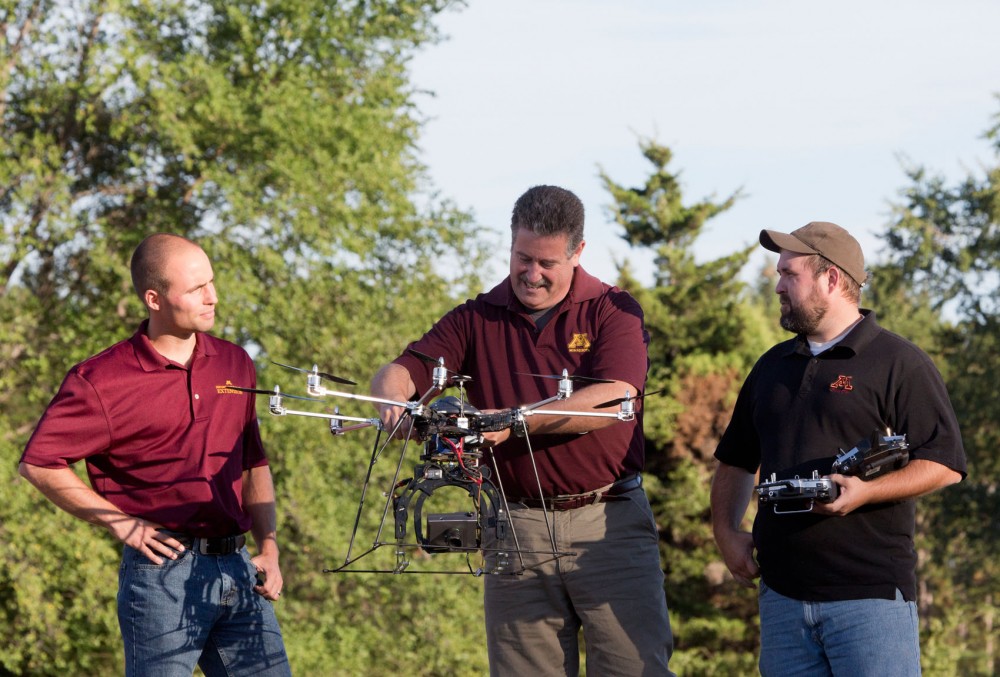Amid the raging national debate over drones infringing on privacy, some University of Minnesota professors are pushing for heavier use of the technology to advance agricultural research.
Last week, the Unmanned Aerial Vehicle Research Group and the College of Food, Agricultural and Natural Resource Sciences requested a $500,000 grant to fund a new precision agriculture research program. If approved by the Office of the Vice President for Research, the program could begin as soon as July 1.
The drone privacy debate arose in Minnesota when Rep. John Lesch, DFL-St. Paul, sponsored a bill that would prohibit government entities from using drones without court permission. But the bill has stalled in the Public Safety Finance and Policy Committee since March 10 and isn’t expected to pass this year. The Federal Aviation Administration permits drone use as a hobby but otherwise requires a special two-year permit to use them.
“Already a lot of farmers are buying UAVs,” said UAV Lab Director Brian Taylor. “But what’s missing is taking the data [that’s collected] and turning it into something that’s actionable by the farmer.”
Farmers who already own drones are capable of collecting data, like images of their crops, Taylor said, but they can’t yet analyze and use that data to increase crop yields. The lab’s precision agriculture program aims to develop and standardize software and techniques that farmers can easily use with their own equipment, he said.
If the researchers are successful and farmers adopt this technology, Taylor said, it could increase the global food supply and reduce the environmental impact of farming.
Ideally, he said, farmers would be able to launch drones to find pest infestations or nutrient deficiencies in their crops. The farmer could then plug that data into a tractor, which would apply the appropriate amounts of pesticide or fertilizer at the right locations.
Applying exact amounts of pesticide, herbicide, water and fertilizer to farmland would conserve resources and reduce runoff, Taylor said, saving the industry money and decreasing pollution.
Minnesota Corn Growers Association Research Director Adam Birr said drone technology is “the next evolution” of precision agriculture because it allows farmers to quickly gather data on thousands of acres of land.
Precision agriculture isn’t a new idea, he said, and satellites have been providing data to farmers for years. But satellites have limitations, he said, and can only collect data when they’re passing over land and there’s no cloud cover. Additionally, he said, farmers often don’t get to see the images until they’re a few months old.
“Having these smaller UAVs have some advantages,” said assistant soil, water and climate professor Daniel Kaiser. “You can go into a field, send one up, scan the entire field and have the data when you want to have the data.”
Kaiser said he wants to use drones to develop better ways for farmers to manage fertilizer. He recently applied for his permit to fly drones for research purposes so he can monitor nutrient deficiencies in crops and soil.
He said drones won’t change the kind of crop data collected but rather will change the way it’s collected.
The technology that drones use to collect data is the same technology that’s on satellites and planes, he said, but drones make getting the data easier.
Assistant entomology professor Robert Koch and associate entomology professor Ian MacRae are currently flying drones in six research locations under special permits they received in January and February.
Koch said their research uses drones to search for signs of crop stress caused by soybean aphids.
The insect feeds on soybean plants and causes distortions in pigmentation that can disrupt how the plants reflect light to stay cool. Those distortions aren’t visible to the human eye, but with the sensors on drones, Koch said, it’s possible to detect that variation and locate possible
infestations.
MacRae said there are still plenty of kinks to work out before farmers can use drone software and techniques, but the new University precision agriculture program could help speed that up.
If legislation passes restricting drone use, MacRae said, it will most likely not affect their research, but rather guide how drones are used.
“[Drone use] is going to be adopted,” he said. “The challenge is to make sure we’re adopting it in a safe and sustainable way.”











